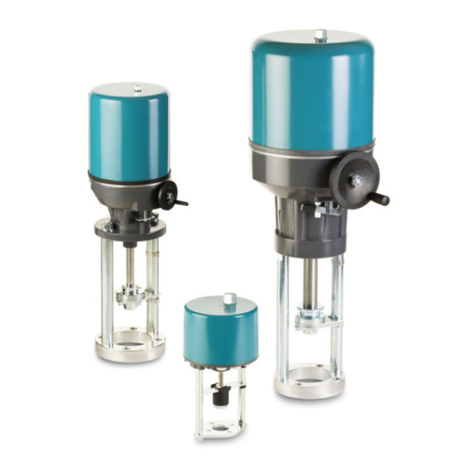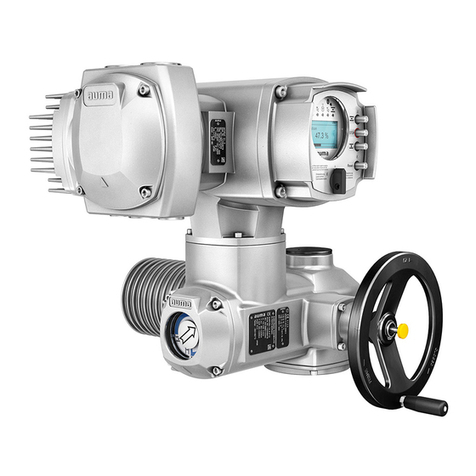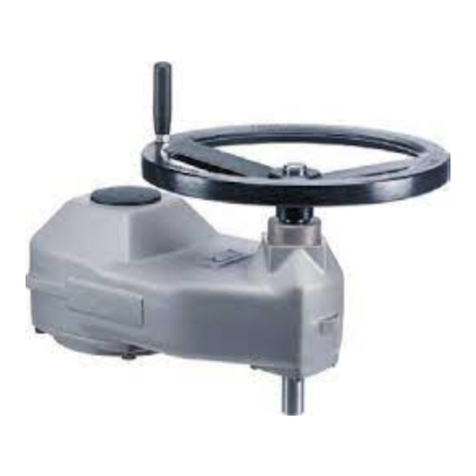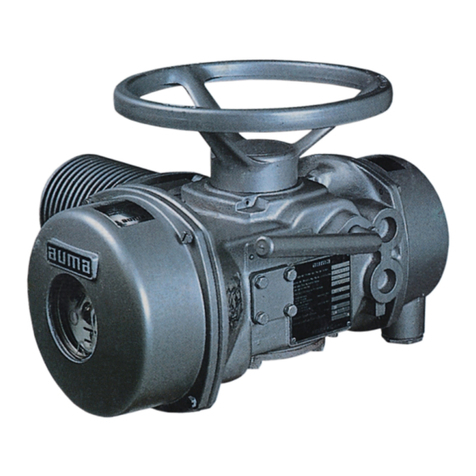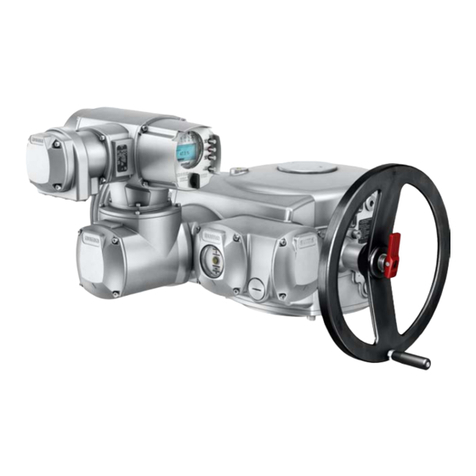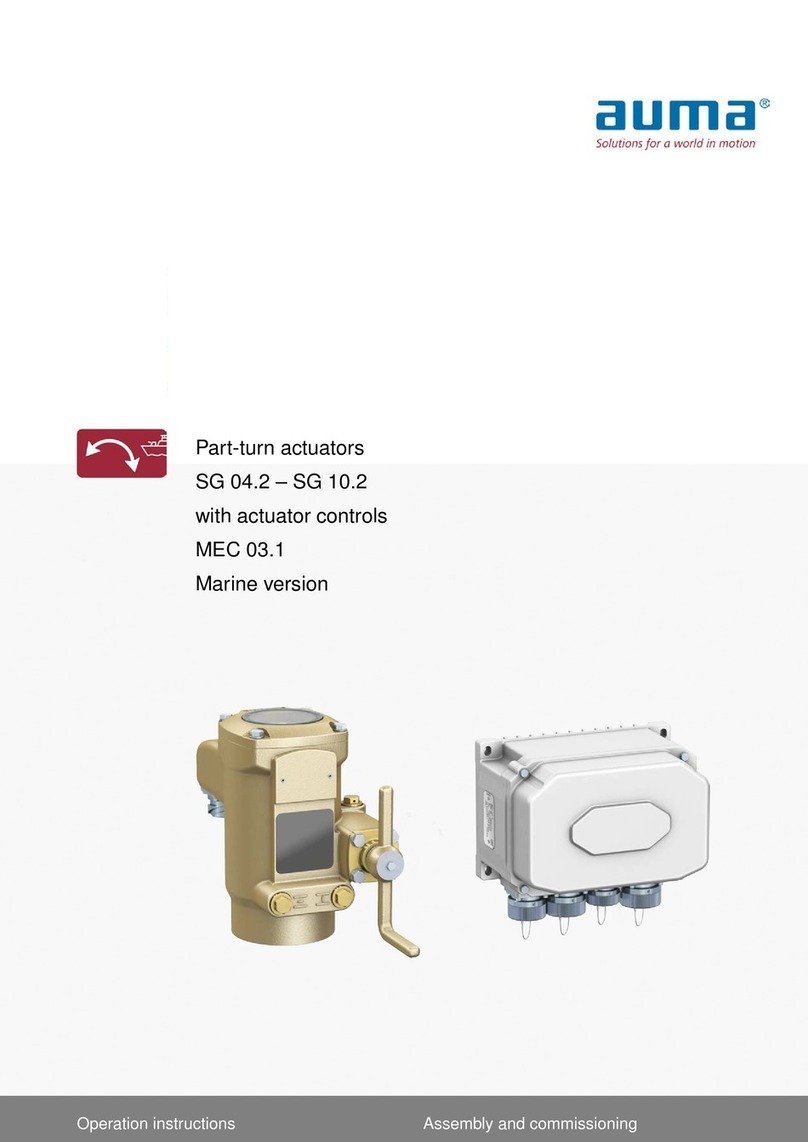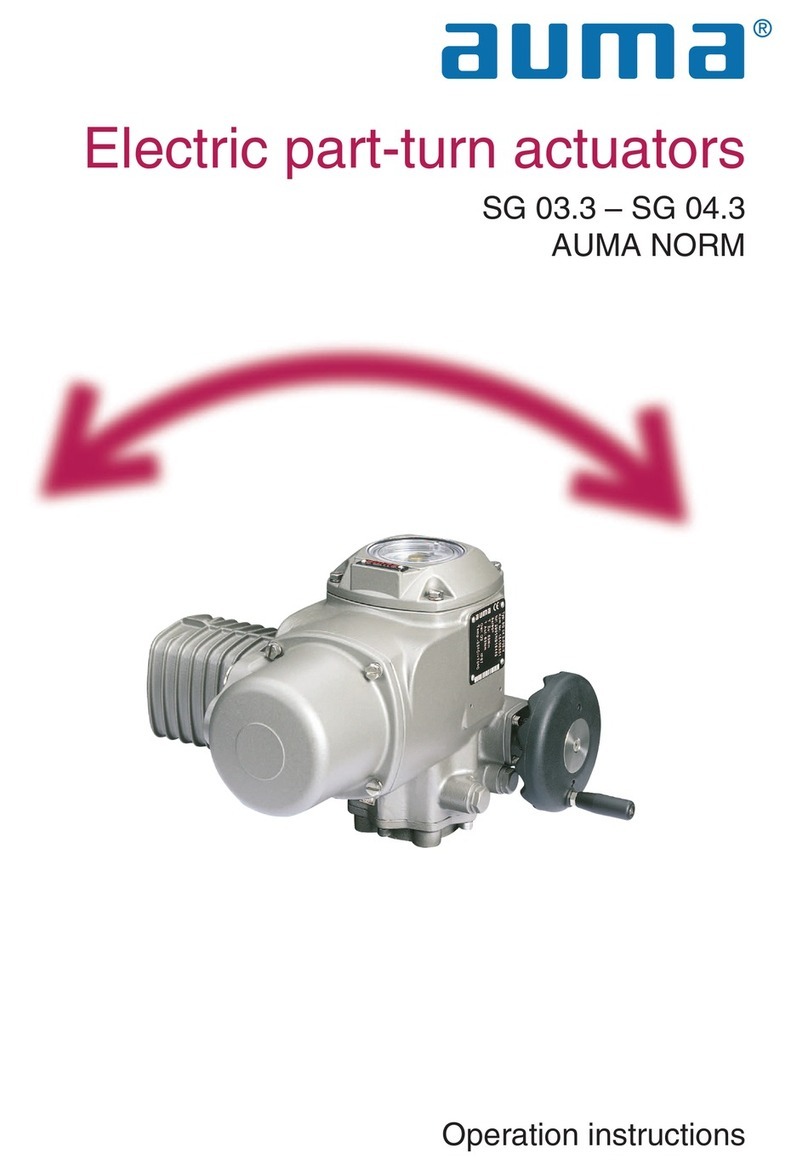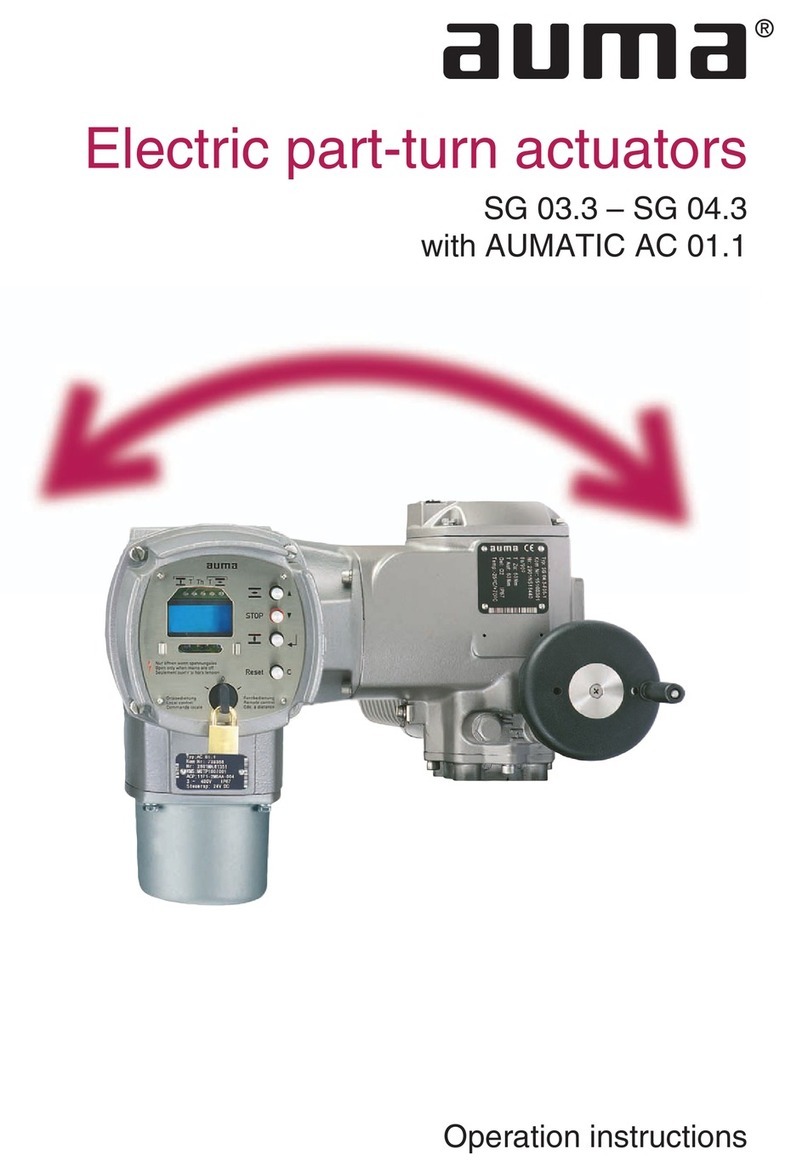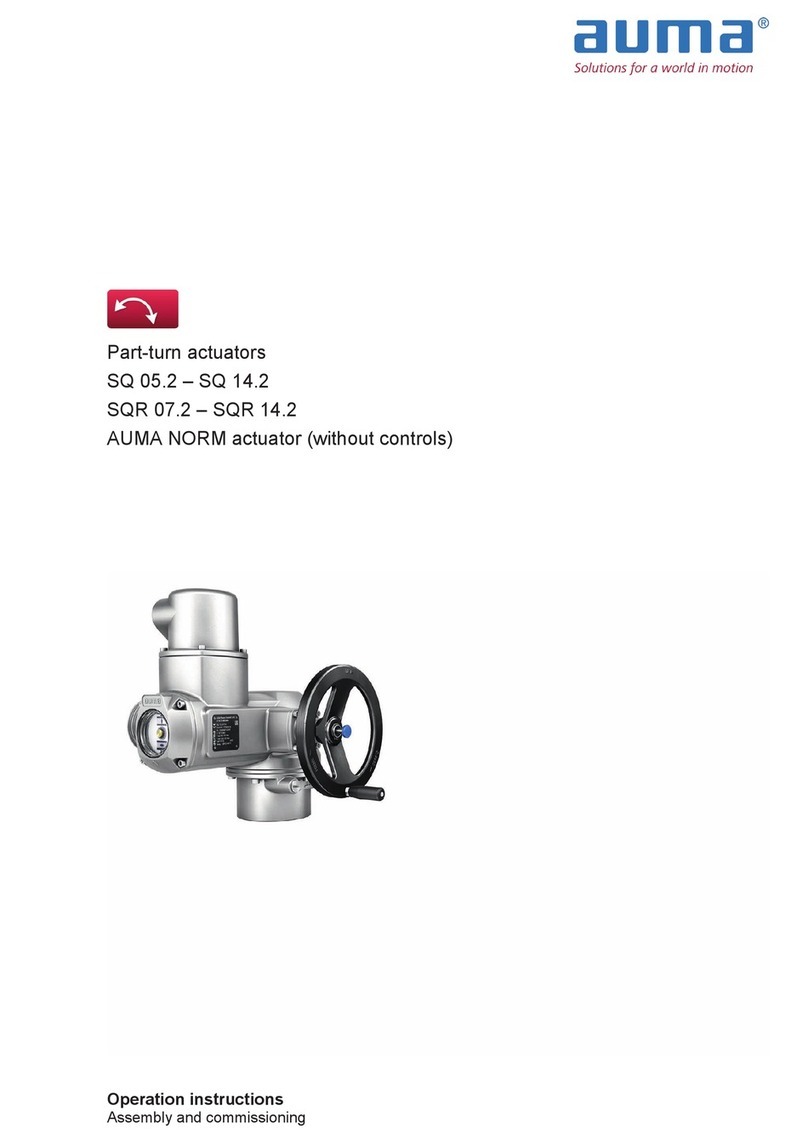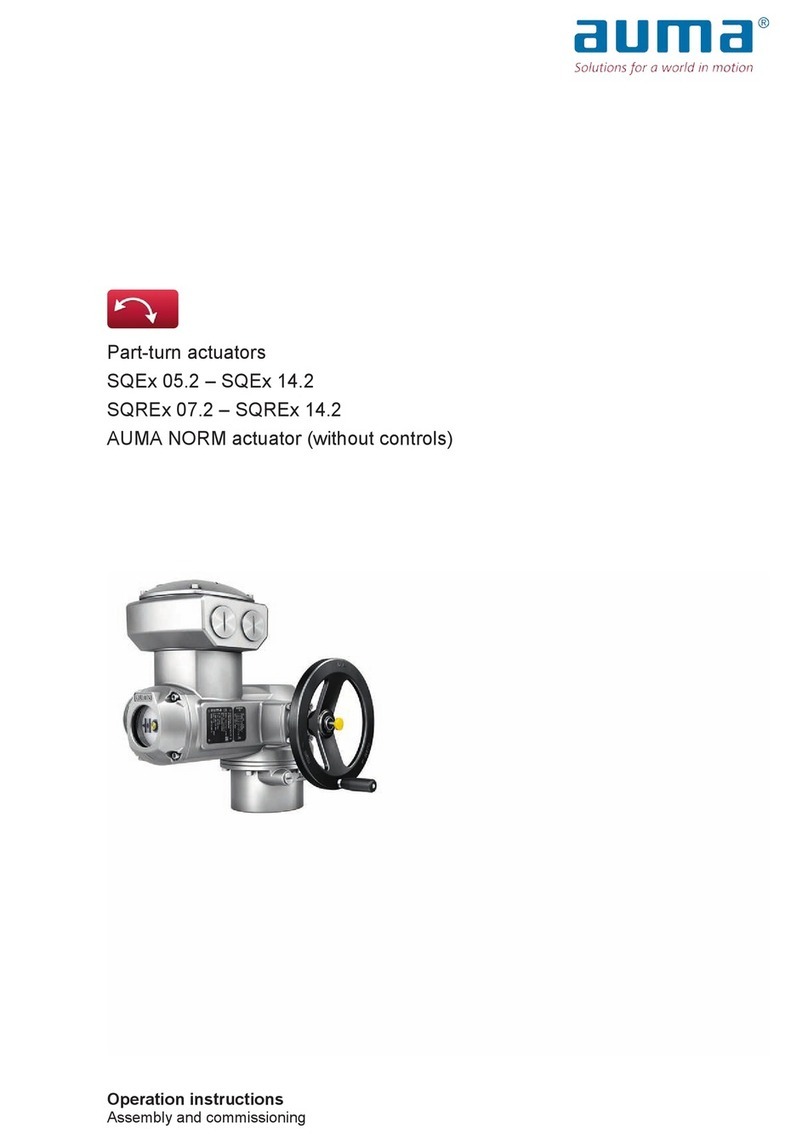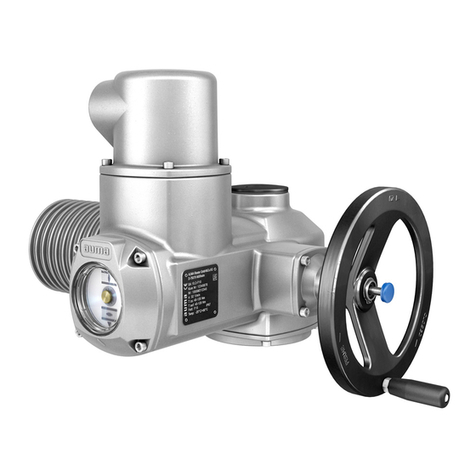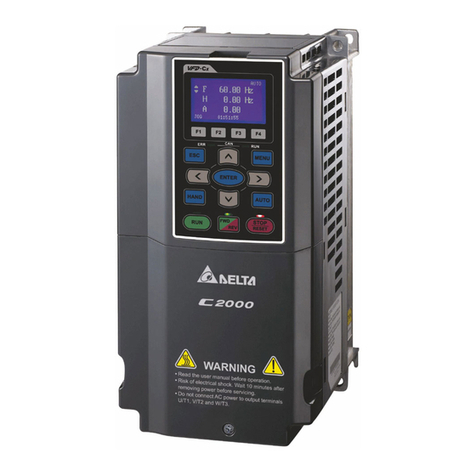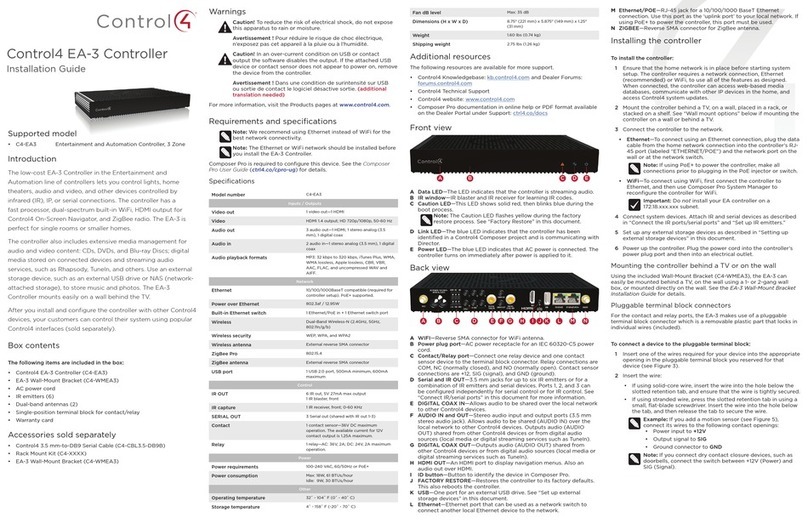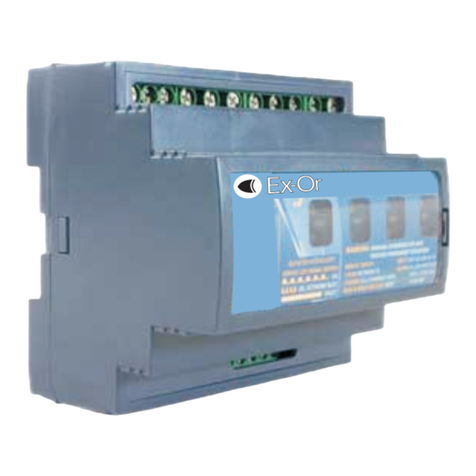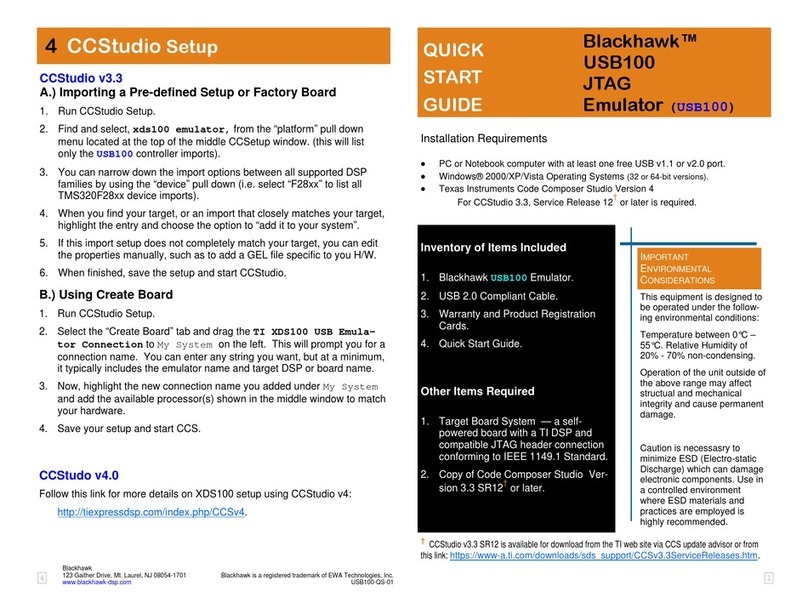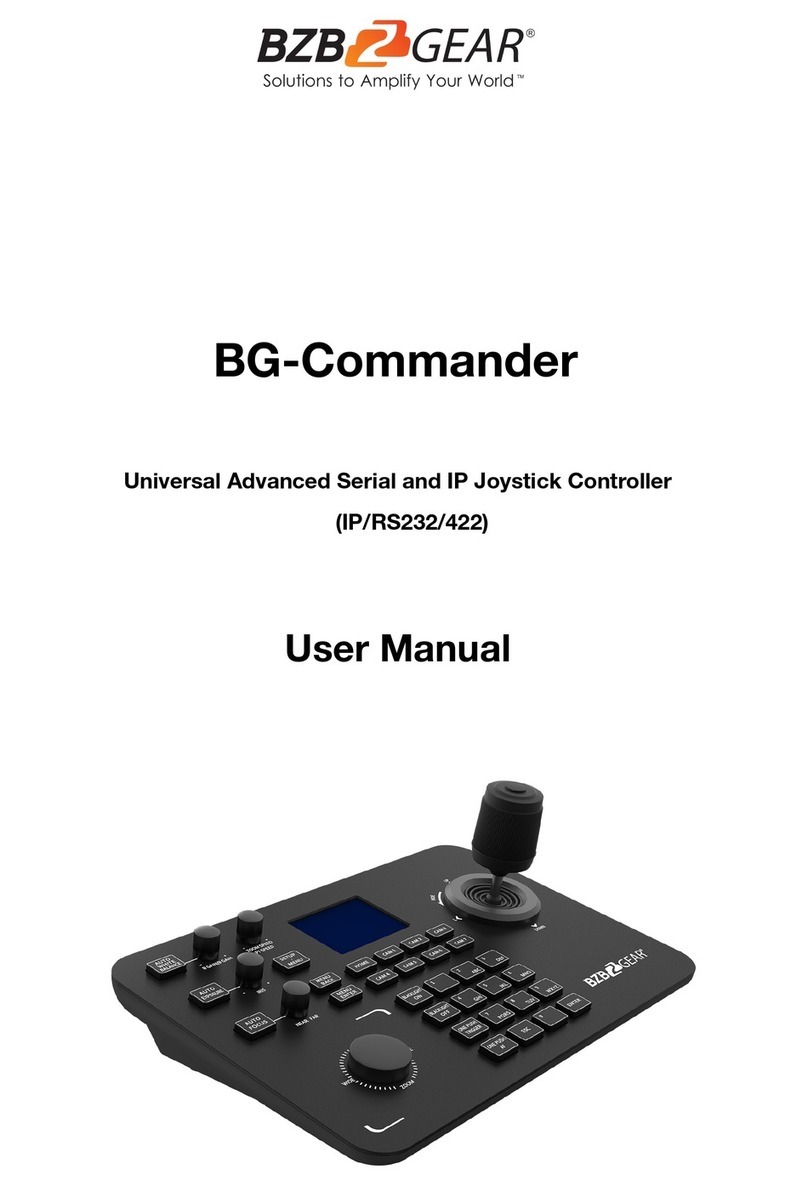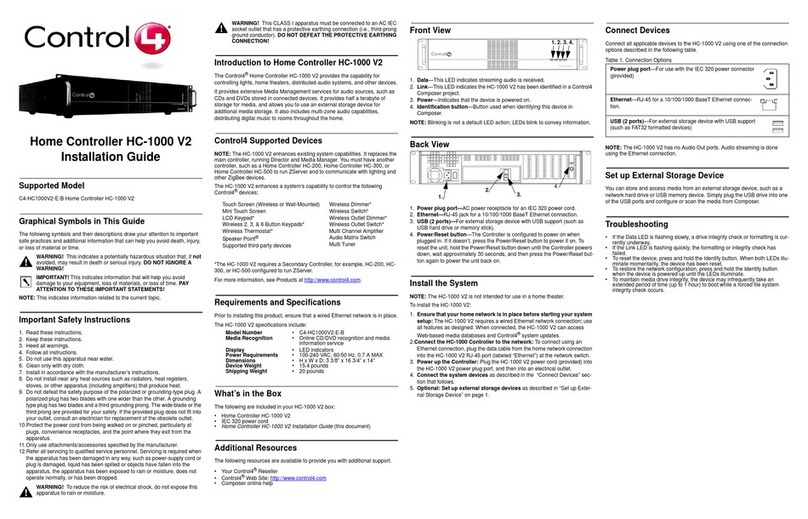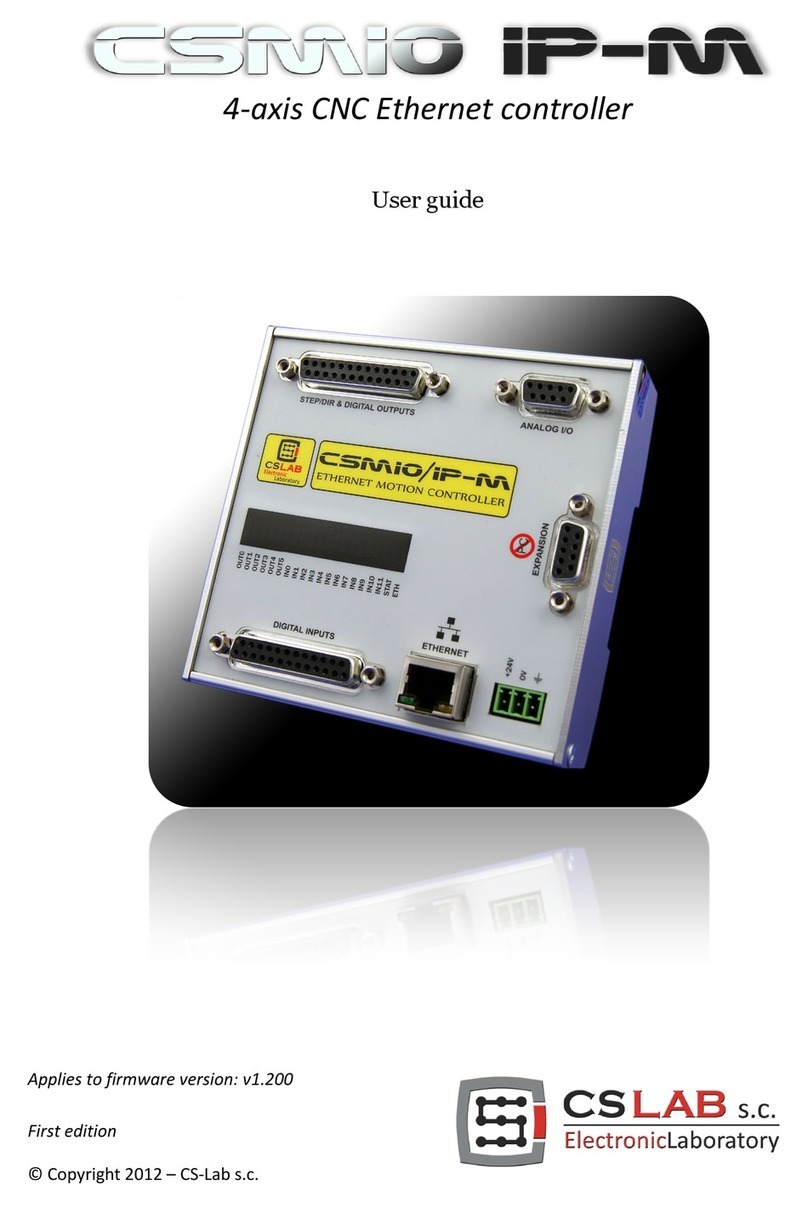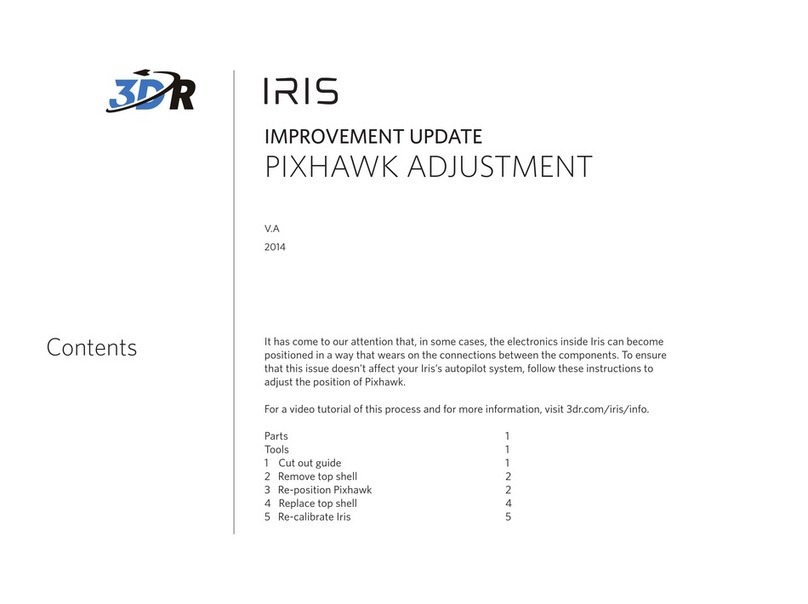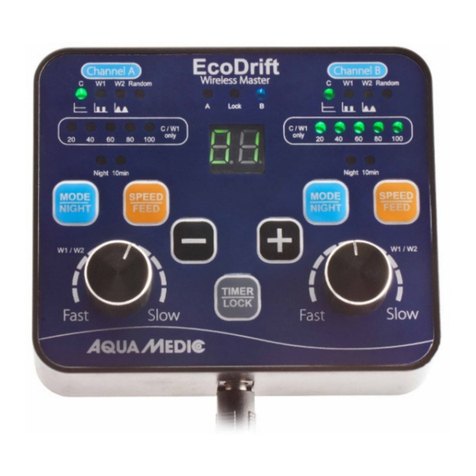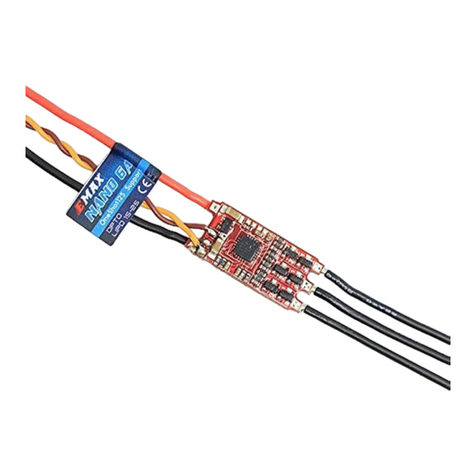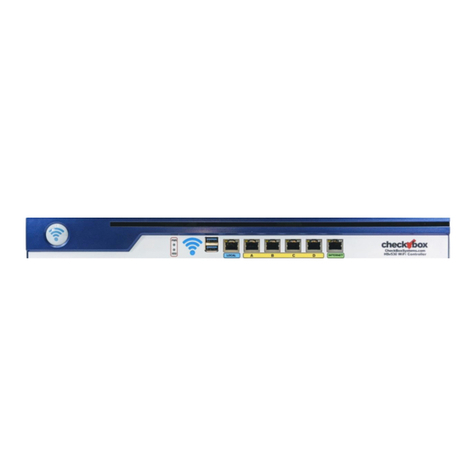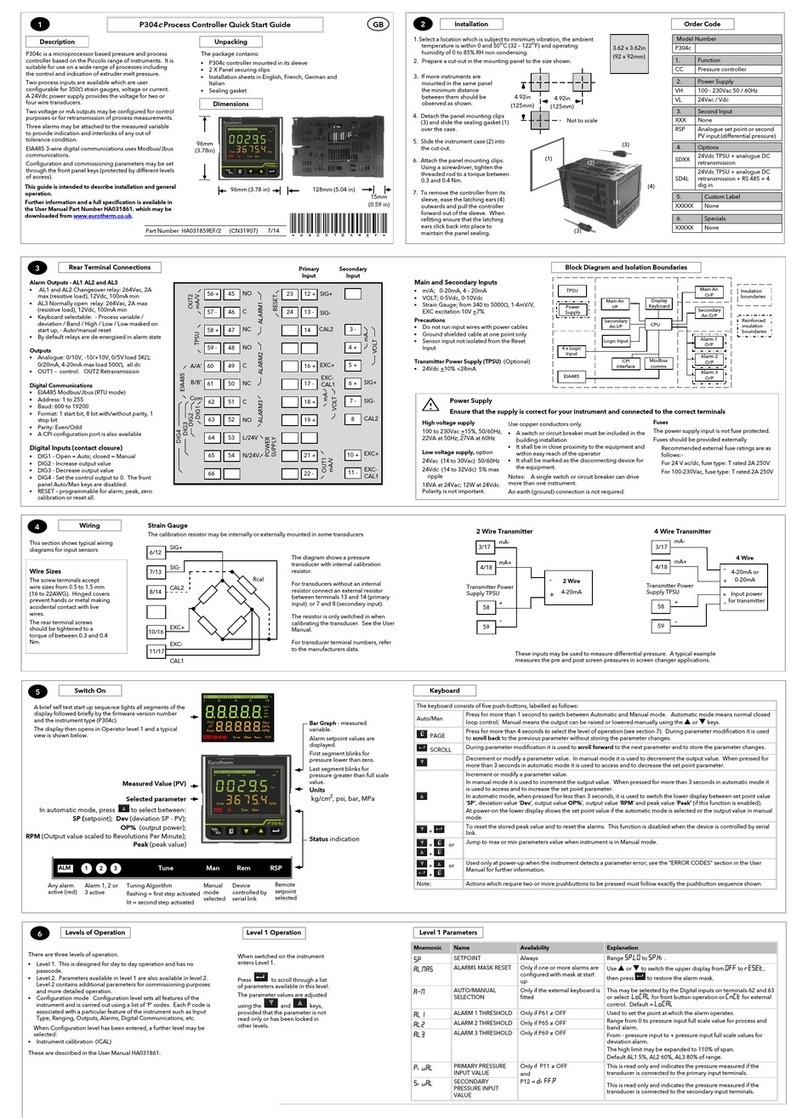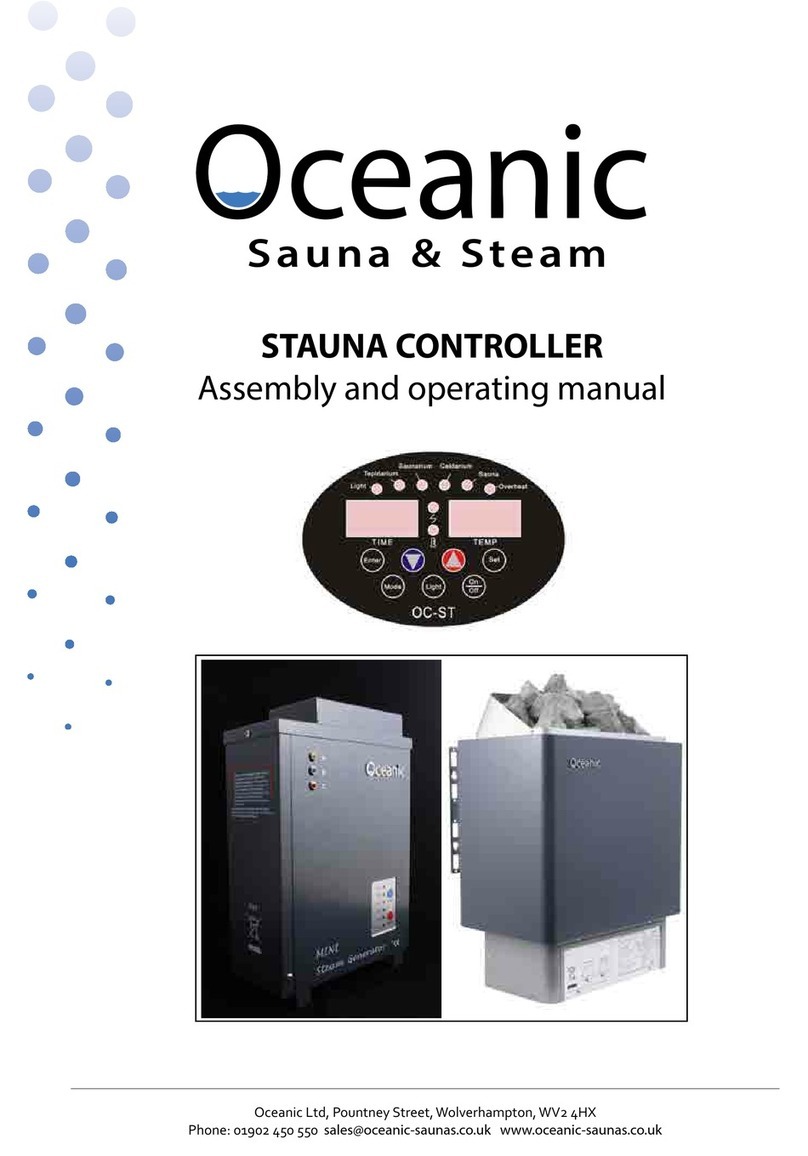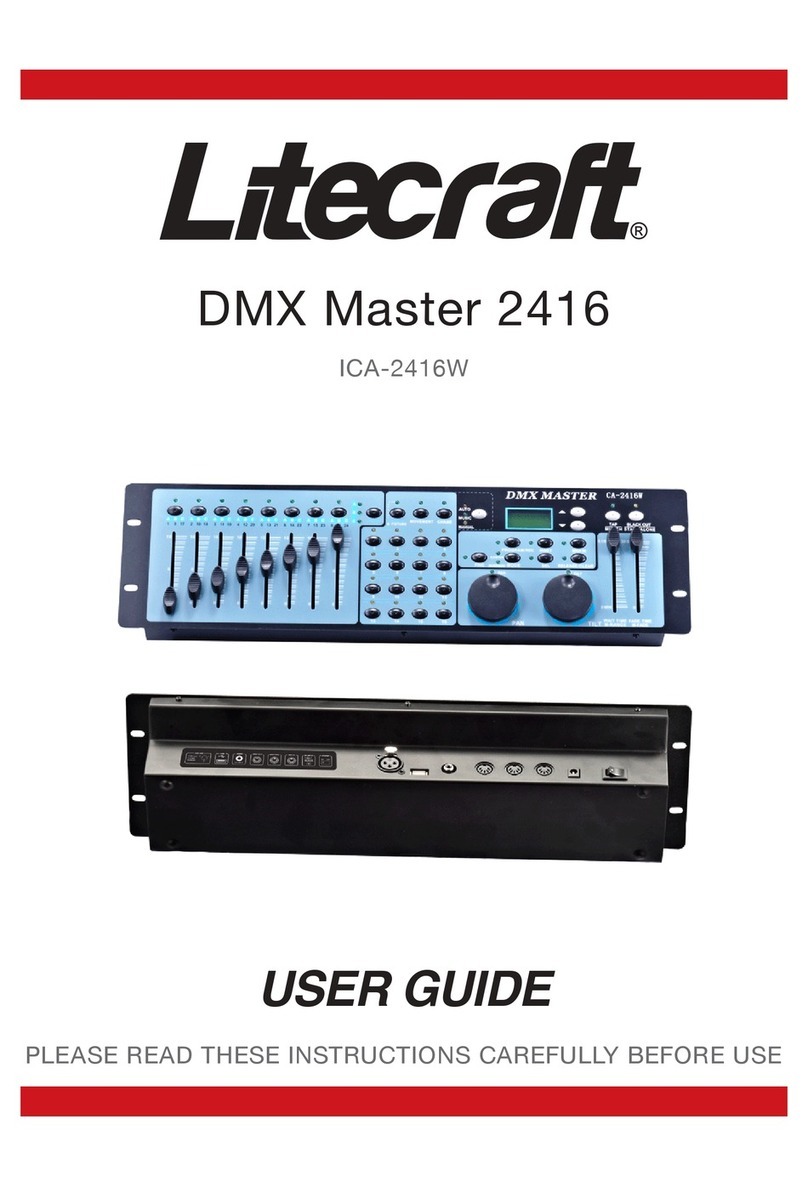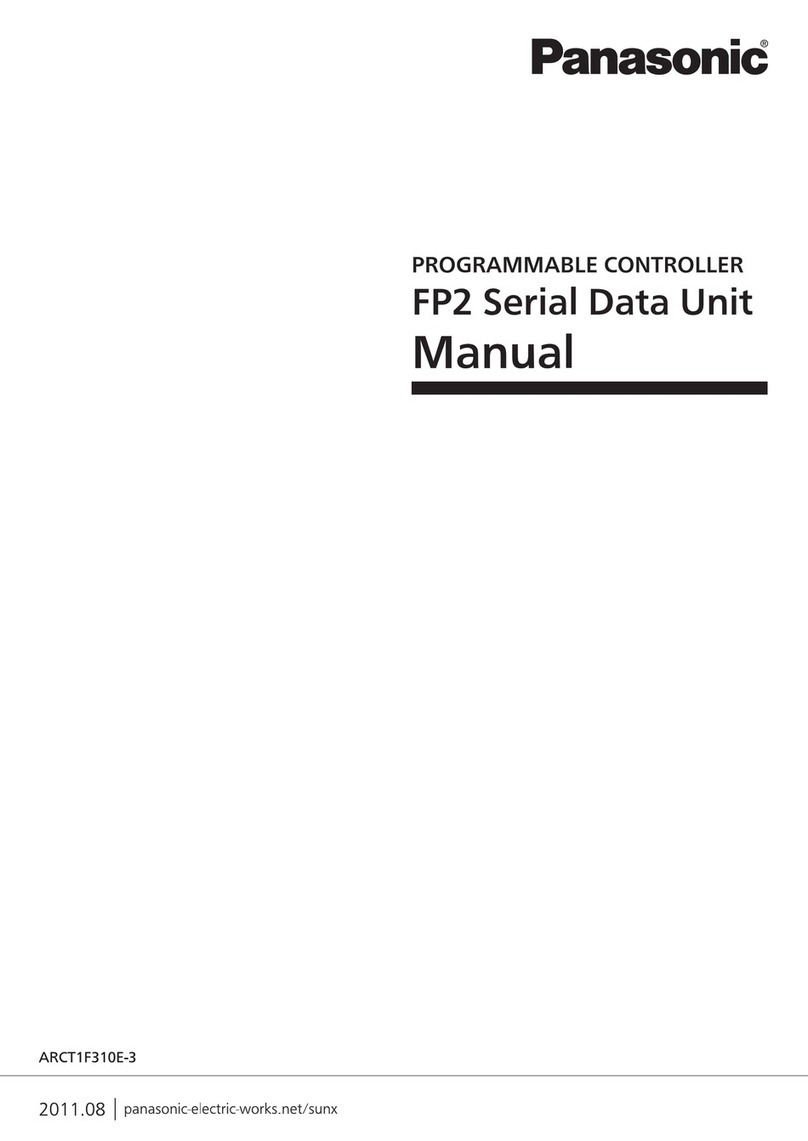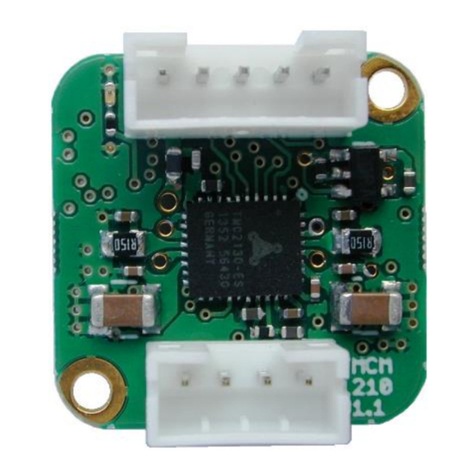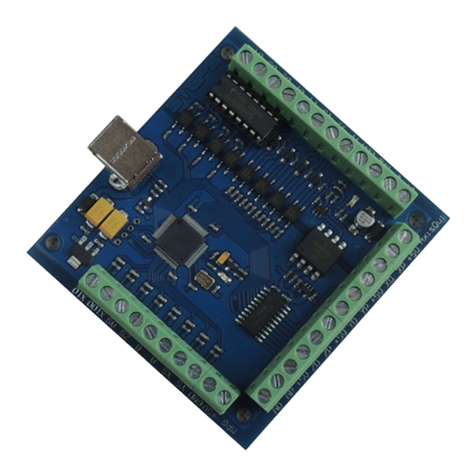AUMA SAR 07.2 User manual

Operation instructions
Assembly and commissioning
Multi-turn actuators
SA 07.2 – SA 16.2
SAR 07.2 – SAR 16.2
AUMA NORM actuator (without controls)

Table of contents
2
Target group:
This document contains information for assembly, commissioning and maintenance staff.
Read operation instructions first.
• Heed safety instructions.
• These operation instructions are part of the product.
• Store operation instructions during product life.
• Pass on instructions to any subsequent user or owner of the product.
Table of contents
1 Safety instructions ........................................................................................................................................... 4
1.1 Prerequisites for the safe handling of the product...................................................................................... 4
1.2 Range of application .................................................................................................................................. 4
1.3 Warnings and notes ................................................................................................................................... 5
1.4 References and symbols............................................................................................................................ 5
2 Short description.............................................................................................................................................. 7
3 Name plate ........................................................................................................................................................ 8
4 Transport and storage ..................................................................................................................................... 11
4.1 Transport.................................................................................................................................................... 11
4.2 Storage....................................................................................................................................................... 13
5 Assembly .......................................................................................................................................................... 14
5.1 Mounting position ....................................................................................................................................... 14
5.2 Fit handwheel............................................................................................................................................. 14
5.3 Mount actuator to valve.............................................................................................................................. 14
5.3.1 Overview of output drive types........................................................................................................ 15
5.3.2 Output drive type A ......................................................................................................................... 15
5.3.3 Output drive types B/C/D/E............................................................................................................. 19
5.4 Accessories for assembly .......................................................................................................................... 20
5.4.1 Stem protection tube for rising valve stem...................................................................................... 20
6 Electrical connection ....................................................................................................................................... 22
6.1 Basic information........................................................................................................................................ 22
6.2 S/SH electrical connection (AUMA plug/socket connector) ....................................................................... 23
6.2.1 Open terminal compartment ........................................................................................................... 24
6.2.2 Cable connection ............................................................................................................................ 24
6.2.3 Close terminal compartment ........................................................................................................... 26
6.3 Accessories for electrical connection (option)............................................................................................ 27
6.3.1 Parking frame.................................................................................................................................. 27
6.3.2 DS intermediate frame for double sealing....................................................................................... 27
6.3.3 External earth connection ............................................................................................................... 28
7 Operation .......................................................................................................................................................... 29
7.1 Manual operation ....................................................................................................................................... 29
7.1.1 Manual valve operation................................................................................................................... 29
7.2 Motor operation .......................................................................................................................................... 30
8 Indications (option) .......................................................................................................................................... 31
8.1 Mechanical position indication via indicator mark ...................................................................................... 31
9 Signals (output signals)................................................................................................................................... 32
9.1 Feedback signals from actuator ................................................................................................................. 32

Table of contents
3
10 Commissioning (basic settings) ..................................................................................................................... 33
10.1 Open switch compartment ......................................................................................................................... 33
10.2 Set torque switching................................................................................................................................... 33
10.3 Set limit switching....................................................................................................................................... 34
10.3.1 Set end position CLOSED (black section) ...................................................................................... 34
10.3.2 Set end position OPEN (white section)........................................................................................... 35
10.4 Test run ...................................................................................................................................................... 35
10.4.1 Check direction of rotation at mechanical position indicator ........................................................... 35
10.4.2 Check direction of rotation at hollow shaft/stem ............................................................................. 36
10.4.3 Check limit switching....................................................................................................................... 36
10.5 Close switch compartment ......................................................................................................................... 37
11 Commissioning (optional equipment settings) ............................................................................................. 38
11.1 Potentiometer............................................................................................................................................. 38
11.1.1 Potentiometer setting ...................................................................................................................... 38
11.2 RWG electronic position transmitter........................................................................................................... 38
11.2.1 Set measuring range....................................................................................................................... 39
11.3 EWG 01.1 electronic position transmitter................................................................................................... 40
11.3.1 Set measuring range....................................................................................................................... 40
11.3.2 Adjust current values ...................................................................................................................... 41
11.3.3 Switch on/off LED end position signalling ....................................................................................... 42
11.4 Set intermediate positions.......................................................................................................................... 42
11.4.1 Set running direction CLOSE (black section).................................................................................. 43
11.4.2 Set running direction OPEN (white section).................................................................................... 43
11.5 Set mechanical position indicator............................................................................................................... 43
12 Corrective actions ............................................................................................................................................ 45
12.1 Faults during operation/commissioning...................................................................................................... 45
12.2 Motor protection (thermal monitoring) ........................................................................................................ 46
13 Servicing and maintenance............................................................................................................................. 47
13.1 Preventive measures for servicing and safe operation .............................................................................. 47
13.2 Maintenance............................................................................................................................................... 48
13.3 Disposal and recycling ............................................................................................................................... 48
14 Technical data .................................................................................................................................................. 49
14.1 Technical data Multi-turn actuators ............................................................................................................ 49
14.2 Tightening torques for screws .................................................................................................................... 51
15 Spare parts list ................................................................................................................................................. 53
15.1 Multi-turn actuators SA 07.2 – SA 16.2 S / SAR 07.2 – SAR 16.2 S ......................................................... 53
Index .................................................................................................................................................................. 55

Safety instructions
4
1Safety instructions
1.1 Prerequisites for the safe handling of the product
Standards/directives The end user or the contractor must ensure that all legal requirements, directives,
guidelines, national regulations and recommendations with respect to assembly, elec-
trical connection, commissioning and operation are met at the place of installation.
Depending on the device version, this includes:
• Configuration guidelines for the respective fieldbus or network applications.
Safety instructions/warn-
ings
All personnel working with this device must be familiar with the safety and warning in-
structions in this manual and heed the instructions given. Safety instructions and
warning signs on the device must be observed to avoid personal injury or property
damage.
Qualification of staff Assembly, electrical connection, commissioning, operation, and maintenance must be
carried out by suitably qualified personnel authorised by the end user or contractor of
the plant only.
Prior to working on this product, the staff must have thoroughly read and understood
these instructions and, furthermore, know and observe officially recognised rules re-
garding occupational health and safety.
Commissioning Prior to commissioning, imperatively check that all settings meet the requirements of
the application. Incorrect settings might present a danger to the application, e.g. cause
damage to the valve or the installation. The manufacturer will not be held liable for any
consequential damage. Such risk lies entirely with the user.
Operation Prerequisites for safe and smooth operation:
• Correct transport, proper storage, mounting and installation, as well as careful
commissioning.
• Only operate the device if it is in perfect condition while observing these instruc-
tions.
• Immediately report any faults and damage and allow for corrective measures.
• Heed recognised rules for occupational health and safety.
• Heed national regulations.
• During operation, the housing warms up and surface temperatures > 60°C may
occur. To prevent possible burns, we recommend checking the surface temperat-
ure using an appropriate thermometer and wearing protective gloves, prior to
working on the device.
Protective measures The end user or the contractor are responsible for implementing required protective
measures on site, such as enclosures, barriers, or personal protective equipment for
the staff.
Maintenance To ensure safe device operation, the maintenance instructions included in this manual
must be observed.
Any device modification requires prior written consent of the manufacturer.
1.2 Range of application
AUMA part-turn actuators SA/SAR are designed for the operation of industrial valves,
e.g. globe valves, gate valves, butterfly valves, and ball valves.
Other applications require explicit (written) confirmation by the manufacturer.
The following applications are not permitted, e.g.:
• Industrial trucks according to EN ISO 3691
• Lifting appliances according to EN 14502
• Passenger lifts according to DIN 15306 and 15309
• Service lifts according to EN 81-1/A1
• Escalators

Safety instructions
5
• Continuous duty
• Buried service
• Continuous underwater use (observe enclosure protection)
• Potentially explosive atmospheres
• Radiation exposed areas in nuclear power plants
No liability can be assumed for inappropriate or unintended use.
Observance of these operation instructions is considered as part of the device's desig-
nated use.
These operation instructions are only valid for the “clockwise closing” standard ver-
sion, i.e. driven shaft turns clockwise to close the valve. For “counterclockwise closing”
version, a supplement must be observed in addition to these operation instructions.
1.3 Warnings and notes
The following warnings draw special attention to safety-relevant procedures in these
operation instructions, each marked by the appropriate signal word (DANGER,
WARNING, CAUTION, NOTICE).
DANGER Indicates an imminently hazardous situation with a high level of risk.
Failure to observe this warning results in death or serious injury.
WARNING Indicates a potentially hazardous situation with a medium level of risk.
Failure to observe this warning could result in death or serious injury.
CAUTION Indicates a potentially hazardous situation with a low level of risk. Fail-
ure to observe this warning could result in minor or moderate injury. May
also be used with property damage.
NOTICE Potentially hazardous situation. Failure to observe this warning could
result in property damage. Is not used for personal injury.
The safety symbol warns of a potential personal injury hazard.
The signal word (here: DANGER) indicates the level of hazard.
1.4 References and symbols
The following references and symbols are used in these instructions:
The term Information preceding the text indicates important notes and inform-
ation.
Information The term Information is part of an instruction and gives important notes and informa-
tion with regard to an action step.
Symbol for CLOSED (valve closed)
Symbol for OPEN (valve open)
Result of a process step
Describes the result of a preceding process step.
Action step
Describes one single action step.
Reference to the page number

Safety instructions
6
Refers to the page number for further information. To return from the target to the pre-
vious view, it is possible to jump back to the previous view within PDF documents:
When using Adobe Acrobat via Menu | Previous view, or using the key combination
Alt + left.

Short description
7
2Short description
Multi-turn actuator Definition according to EN 15714-2/EN ISO 5210 or EN ISO 22153:
A multi-turn actuator is an actuator which transmits torque to a valve for at least one
full revolution and can withstand thrusts.
AUMA multi-turn actuator Figure1: Example: AUMA SA 10.2 multi-turn actuator
[1]
[2]
[3]
[4]
[5]
[1] Motor [2] Electrical connection
[3] Handwheel [4] Valve attachment
[5] Mechanical position indicator
AUMA SA/SAR multi-turn actuators are driven by an electric motor. A handwheel is
available for setting and emergency operation.
Actuator controls are required to operate or process the actuator signals.
Actuators without controls can be equipped with AUMA actuator controls at a later
date. For any queries, please state our order number. The order number is available
on the name plate. (Refer to Actuator name plate [}8].)
Switching off in end positions may be either by limit or torque seating.
In combination with output drive type A, the actuator is capable of withstanding thrust.

Name plate
8
3Name plate
Figure2: Arrangement of name plates
[1]
[2] [3]
[1] Motor name plate [2] Actuator name plate
[3] Additional plate, e.g. KKS plate (Power
Plant Classification System)
Actuator name plate
Figure3: Actuator name plate (example)
[1]
[2]
[3]
[4]
[5]
[6]
[7]
[8]
[9]
[10]
[11]
[12]
[13]
[1] Name of manufacturer [2] Address of manufacturer
[3] Type designation [4] Order number
[5] Serial number [6] Speed
[7] Torque range in direction CLOSE [8] Torque range in direction OPEN
[9] Type of lubricant [10] Permissible ambient temperature
[11] Can be assigned as an option upon
customer request
[12] Enclosure protection
[13] Data Matrix code

Name plate
9
Motor name plate
Figure4: Motor name plate (example)
[1]
[2]
[3]
[4]
[5]
[6]
[7]
[8]
[9]
[10]
[11]
[12]
[13]
[14]
[1] Motor type [2] Motor article number
[3] Serial number [4] Current type, mains voltage
[5] Nominal power [6] Nominal current
[7] Type of duty [8] Enclosure protection
[9] Motor protection (temperature protec-
tion)
[10] Insulation class
[11] Data Matrix code [12] Mains frequency
[13] Power factor cos phi [14] Speed
Descriptions referring to name plate indications
Type designation Table1: Description of type designation with the example of SA 07.2-F10
SA 07.2 -F10
SA Type SA = Multi-turn actuators for open-close duty
Type SAR = Multi-turn actuators for modulating duty
07.2 Size
These instructions apply to sizes 07.2, 07.6, 10.2, 14.2, 14.6, 16.2
F10 Flange size
Order number The product can be identified using this number and the technical data as well as or-
der-related data pertaining to the device can be requested.
Please always state this number for any product inquiries.
On our website at http://www.auma.com, via Service & Support| myAUMA, we of-
fer a service allowing authorised users to download order-related documents such as
wiring diagrams and technical data (both in German and English), inspection certific-
ate and the operation instructions when entering the order number.
Actuator serial number Table2: Serial number until 2023, description with the example of 0523MD12345
05 23 MD12345
05 Positions 1+2: Assembly in week = week 05
23 Positions 3+4: Year of manufacture = 2023
MD12345 Internal number for unambiguous product identification
Table3: Serial number as from 2024, description with the example 0000-00101-2024
00000-00101 – 2024
00000-00101 Serial number of sales article
11-digit, internal number for unambiguous product identification
2024 Year of manufacture = 2024
Data Matrix code When registered as authorised user, you may use our AUMA Assistant App to scan
the Data Matrix code and directly access the order-related product documents without
having to enter order number or serial number.

Name plate
10
Figure5: Link to AUMA Assistant App
For further Service & Support, Software/Apps/..., refer to www.auma.com.

Transport and storage
11
4Transport and storage
4.1 Transport
Actuator For transport to place of installation, use sturdy packaging.
DANGER Suspended load!
Death or serious injury.
àDo NOT stand below suspended load.
àAttach ropes or hooks for the purpose of lifting by hoist only to housing and NOT
to handwheel.
àActuators mounted on valves: Attach ropes or hooks for the purpose of lifting by
hoist to valve and NOT to actuator.
àActuators mounted to gearboxes: Attach ropes or hooks for the purpose of lifting
by hoist only to the gearbox using eyebolts and NOT to the actuator.
àRespect total weight of combination (actuator, gearbox, valve)
àSecure load against falling down, sliding or tilting.
àPerform lift trial at low height to eliminate any potential danger e.g. by tilting.
Figure6: Example: Lifting the actuator
Weights Table4: Weights for SA/SAR multi-turn actuators with 3-phase motors
Type designation
Actuator
Motor type1) Weight2)
approx. [kg]
SA 07.2/
SAR 07.2
VD... 19
AD... 20
SA 07.6/
SAR 07.6
VD... 20
AD... 21
SA 10.2/
SAR 10.2
VD... 22
AD... 25
SA 14.2/
SAR 14.2
VD... 44
AD... 48
SA 14.6/
SAR 14.6
VD... 46
AD... 53
SA 16.2/
SAR 16.2
VD... 67
AD... 83
1) Refer to motor name plate
2) Indicated weight includes AUMA NORM multi-turn actuator with 3-phase AC motor, electrical connection in standard version, output drive
type B1 and handwheel. For other output drive types, consider additional weights.

Transport and storage
12
Table5: Weights for SA/SAR multi-turn actuators with 1-phase motors
Type designation
Actuator
Motor type3) Weight4)
approx. [kg]
SA 07.2/
SAR 07.2
VB... 21
VE... 21
AE... 28
SA 07.6/
SAR 07.6
VB... 21
VE... 25
AE... 28
AC... 37
SA 10.2/
SAR 10.2
VE...48-4... 28
VE...48-2... 31
AC... 56-4... 40
AC... 56-2... 43
SA 14.2/
SAR 14.2
VE... 59
VC... 61
AC... 63
SA 14.6/
SAR 14.6
VE... 63
VC... 66
Table6: Weights for SA/SAR multi-turn actuators with DC motors
Type designation
Actuator
Motor type5) Weight6)
approx. [kg]
SA 07.2/
SAR 07.2
FN... 63-... 29
FN... 71-... 32
SA 07.6/
SAR 07.6
FN... 63-... 30
FN... 80-... 44
SA 10.2/
SAR 10.2
FN... 63-... 33
FN... 71-... 36
FN... 90-... 56
SA 14.2/
SAR 14.2
FN... 71-... / FN... 80-... 68
FN... 90-... 100
SA 14.6/
SAR 14.6
FN... 80-... / FN... 90-... 76
FN... 112-... 122
SA 16.2/
SAR 16.2 FN... 100-... 123
Table7: Weights of output drive types A
Type designation Flange size [kg]
A 07.2 F07 1.1
A 07.2 F10 1.3
A 10.2 F10 2.8
A 14.2 F14 6.8
A 16.2 F16 11.7
3) Refer to motor name plate
4) Indicated weight includes AUMA NORM multi-turn actuator with 1-phase AC motor, electrical connection in standard version, output drive
type B1 and handwheel. For other output drive types, consider additional weights.
5) Refer to motor name plate
6) Indicated weight includes AUMA NORM multi-turn actuator with DC motor, electrical connection in standard version, output drive type B1
and handwheel. For other output drive types, consider additional weights.

Transport and storage
13
4.2 Storage
NOTICE Danger of corrosion due to inappropriate storage!
àStore in a well-ventilated, dry room.
àProtect against floor dampness by storage on a shelf or on a wooden pallet.
àCover to protect against dust and dirt.
àApply suitable corrosion protection agent to uncoated surfaces.
Long-term storage For long-term storage (more than 6 months), observe the following points:
1. Prior to storage: Protect uncoated surfaces, in particular the output drive parts and
mounting surface, with long-term corrosion protection agent.
2. At an interval of approx. 6 months: Check for corrosion. If first signs of corrosion
show, apply new corrosion protection.

Assembly
14
5Assembly
5.1 Mounting position
When using grease as lubricant, the product described herein can be operated in any
mounting position.
When using oil instead of grease within the actuator gear housing, perpendicular
mounting position is specified whereby the flange is pointing downward. The type of
lubricant used is indicated on the actuator name plate (short designation F...= grease;
O...= oil).
5.2 Fit handwheel
To avoid transport damage, handwheels are supplied separately as appropriate. In
this instance, the handwheel must be mounted prior to commissioning.
Figure7: Handwheel
[1]
[2] [3]
[4]
[1] Spacer [2] Input shaft
[3] Handwheel [4] Retaining ring
How to proceed 1. If required, fit spacer [1] on input shaft [2].
2. Slip handwheel [3] onto input shaft.
3. Secure handwheel [3] with retaining ring [4].
Information:The retaining ring [4] (together with these operation instructions) is
stored in a weatherproof bag, which is attached to the device prior to delivery.
5.3 Mount actuator to valve
NOTICE Corrosion due to damage to paint finish and condensation!
àTouch up damage to paint finish after work on the device.
àAfter mounting, connect the device immediately to electrical mains to ensure that
heater minimises condensation.

Assembly
15
5.3.1 Overview of output drive types
Table8: Overview on output drive types
Valve attach-
ment
Application Further information
Output drive type
A
Threads
• for rising, non-rotating valve stem
• For transmission of torques and thrusts
• Not appropriate for withstanding radial forces Output drive type A
[}15]
Bore with keyway, square bore, hexagon bore
• for rotating, non-rising valve stem
• For transmission of torques and thrusts
• Not appropriate for withstanding radial forces
Output drives
B, B1 – B4
C, D, E
Valve shaft, gearbox shaft
• Only for transmission of torques
• Not appropriate for withstanding thrust
Output drive types B/
C/D/E [}19]
5.3.2 Output drive type A
Figure8: Design of output drive type A
[1]
[2]
[3]
[1] Output mounting flange [2] Stem nut
[3] Valve stem
Short description Output drive type A consisting of output mounting flange [1] with axial bearing stem
nut [2]. The stem nut transmits the torque from the actuator hollow shaft to the valve
stem [3]. Output drive type A can withstand thrusts.
To adapt the actuators to available output drive types A with flanges F10 and F14
(year of manufacture 2009 and earlier), an adapter is required. The adapter can be
ordered with AUMA.
5.3.2.1 Mount multi-turn actuator with output drive type A
1. If output drive type A is already mounted to the multi-turn actuator: Loosen screws
[3] and remove output drive type A [2].

Assembly
16
Figure9: Multi-turn actuator with output drive type A
[1]
[2]
[3]
[1] Multi-turn actuator [2] Output drive type A, from left to right:
with machined, unbored and pilot bore
stem nut
[3] Screws to multi-turn actuator
For an unbored or pilot bore stem nut, the stem nut must be finish-machined
prior to mounting valve stem and prior to performing the following steps: Finish
machining of stem nut for output drive type A [}17]
2. Apply a small quantity of grease to the valve stem.
3. Place output drive type A [2] on valve stem and turn until output drive type A [2] is
flush on the valve flange [4].
4. Turn output drive type A [2] until alignment of the fixing holes.
5. Fasten screws [5] between valve and output drive type A [2] without completely
tightening them.
Figure10:
6. Fit multi-turn actuator on the valve stem so that the stem nut dogs engage into the
output drive sleeve.

Assembly
17
Figure11:
ðThe flanges are flush with each other if properly engaged.
7. Adjust multi-turn actuator until alignment of the fixing holes.
8. Fasten multi-turn actuator with screws [3].
9. Fasten screws [3] crosswise with a torque according to table Tightening torques
for screws [}51].
10. Turn multi-turn actuator with handwheel in direction OPEN until valve flange [4]
and output drive type A [2] are firmly placed together.
Figure12: Tighten flange
11. Tighten screws [5] between valve and output drive type A crosswise applying a
torque according to table Tightening torques for screws [}51].
5.3.2.2 Finish machining of stem nut for output drive type A
This working step is only required if stem nut is supplied unbored or with pilot bore.
For exact product version, please refer to the order-related technical data
sheet or the AUMA Assistant App.

Assembly
18
Figure13: Output drive type A
[1]
[2]
[3]
[2]
[2.1]
[2.2]
[2.1]
[2.1]
[2.1]
[2.2]
[1] Stem nut [2] Axial needle roller bearing
[2.1] Axial bearing washer [2.2] Axial needle roller and cage assembly
[3] Spigot ring
How to proceed 1. Remove spigot ring [3] from output drive.
2. Remove stem nut [1] together with axial needle roller bearing [2].
3. Remove axial bearing washers [2.1] and axial needle roller and cage assemblies
[2.2] from stem nut [1].
4. Drill and bore stem nut [1] and cut thread.
5. Clean the machined stem nut [1].
6. Apply sufficient Lithium soap EP multi-purpose grease to axial needle roller and
cage assemblies [2.2] and axial bearing washers [2.1], ensuring that all hollow
spaces are filled with grease.
7. Place greased axial needle roller and cage assemblies [2.2] and axial bearing
washers [2.1] onto stem nut [1].
8. Re-insert stem nut [1] with axial needle roller bearings [2] into output drive.
9. Screw in spigot ring [3] until firm seat against the shoulder.

Assembly
19
5.3.3 Output drive types B/C/D/E
Figure14: Mounting principle
[1]
[2]
[3]
[4]
B1
C D
B2
B
B3
B4
E
[1] Flange multi-turn actuator (e.g. F07) [2] Hollow shaft
[3] Output drive sleeve (illustration ex-
amples)
[4] Gearbox/valve shaft
Short description Connection between hollow shaft and valve or gearbox via output drive sleeve fixed to
the hollow shaft of the multi-turn actuator via retaining ring.
When exchanging the output drive sleeve, later retrofitting to a different output drive
type is possible.
• Output drive type B/E:
Output drive sleeve with bore according toDIN 3210
• Output drive types B1/B3:
Output drive sleeve with bore according to EN ISO 5210
• Output drive types B2/B4:
Output drive sleeve with bore according to customer order
B4 including special bores like bores without keyway, square bore, hexagon bore,
internal splines
• Output drive type C:
Output drive sleeve with dog coupling according to EN ISO 5210 or DIN 3338
• Output drive type D:
Shaft end with key according to EN ISO 5210 or DIN 3210
Spigot at valve flanges should be loose fit.

Assembly
20
5.3.3.1 Mount multi-turn actuator with output drive type B
Figure15: Mounting output drive types B
[1]
[2]
[3]
[4]
[1] Multi-turn actuator [2] Valve/gearbox
[3] Valve/gearbox shaft [4] Screw
How to proceed 1. Check if mounting flanges fit together.
2. Check, if output drive of multi-turn actuator [1] matches the output drive of valve/
gearbox or valve/gearbox valve shaft [2/3].
3. Apply a small quantity of grease to the valve or gearbox stem [3].
4. Place multi-turn actuator [1] and ensure that the spigot fits uniformly in the recess
and that the mounting faces are in complete contact.
5. Fasten multi-turn actuator with screws [4].
Information:We recommend applying liquid thread sealing material to the screws
to avoid contact corrosion.
6. Fasten screws [4] crosswise with a torque according to table Tightening torques
for screws [}51].
5.4 Accessories for assembly
5.4.1 Stem protection tube for rising valve stem
Figure16: Assembly of the stem protection tube
[1]
[2]
[3]
[4]
[1] Protective cap for stem protection tube
(fitted)
[2] Stem protection tube
[3] V-seal [4] Option: Protective cap made of steel
(screwed)
This manual suits for next models
3
Table of contents
Other AUMA Controllers manuals
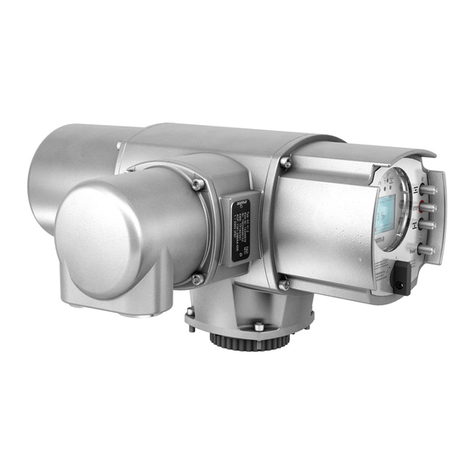
AUMA
AUMA ACE C 01.2 Profinet Series User manual
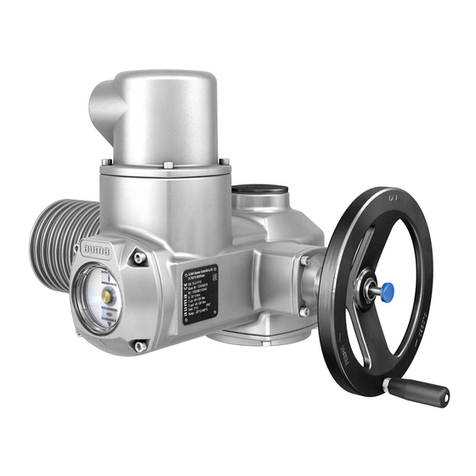
AUMA
AUMA SA 07.2 User manual
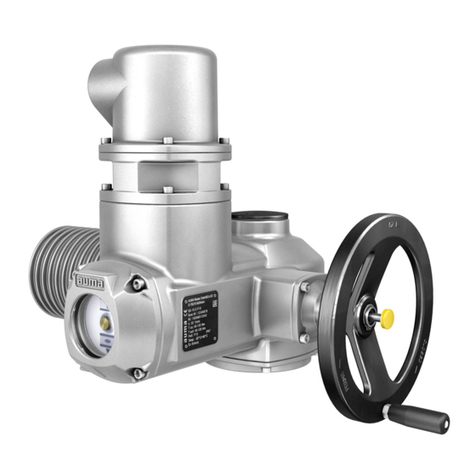
AUMA
AUMA SAREx 07.2 - SAREx 16.2 User manual
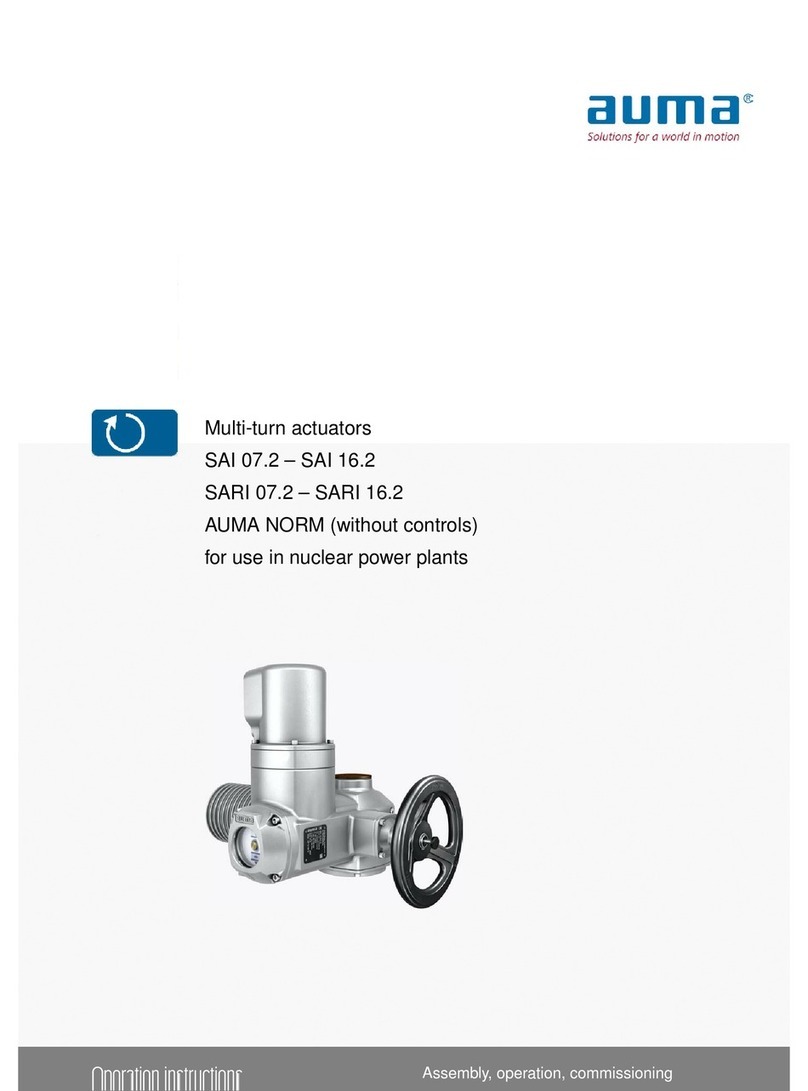
AUMA
AUMA SAI 07.2 User manual
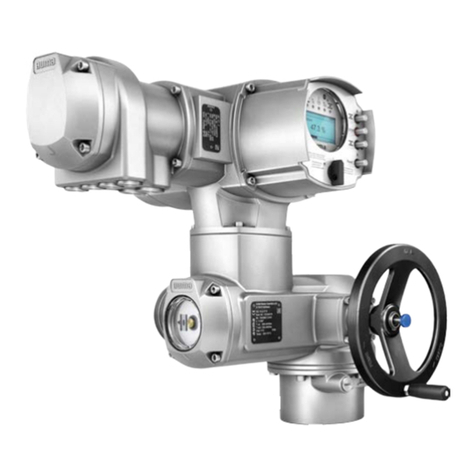
AUMA
AUMA SQ 05.2 User manual

AUMA
AUMA SA Series User manual
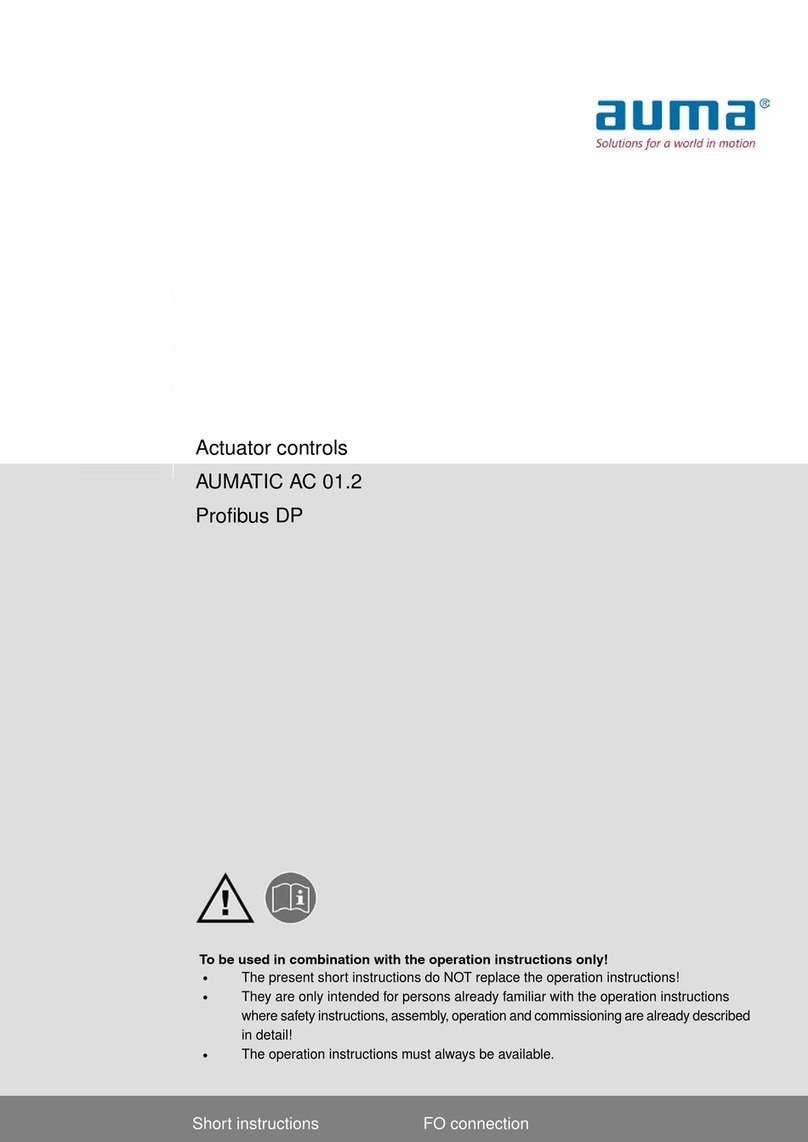
AUMA
AUMA AUMATIC AC 01.2 Manual
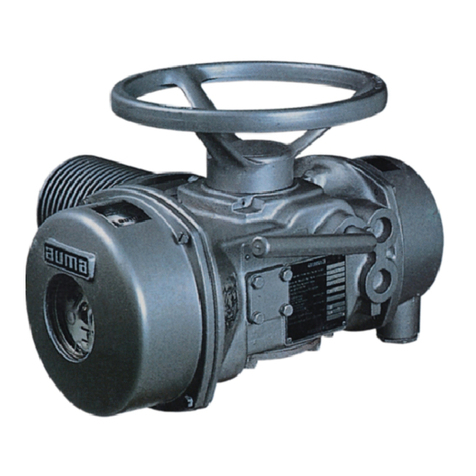
AUMA
AUMA SA3-SA100 User manual
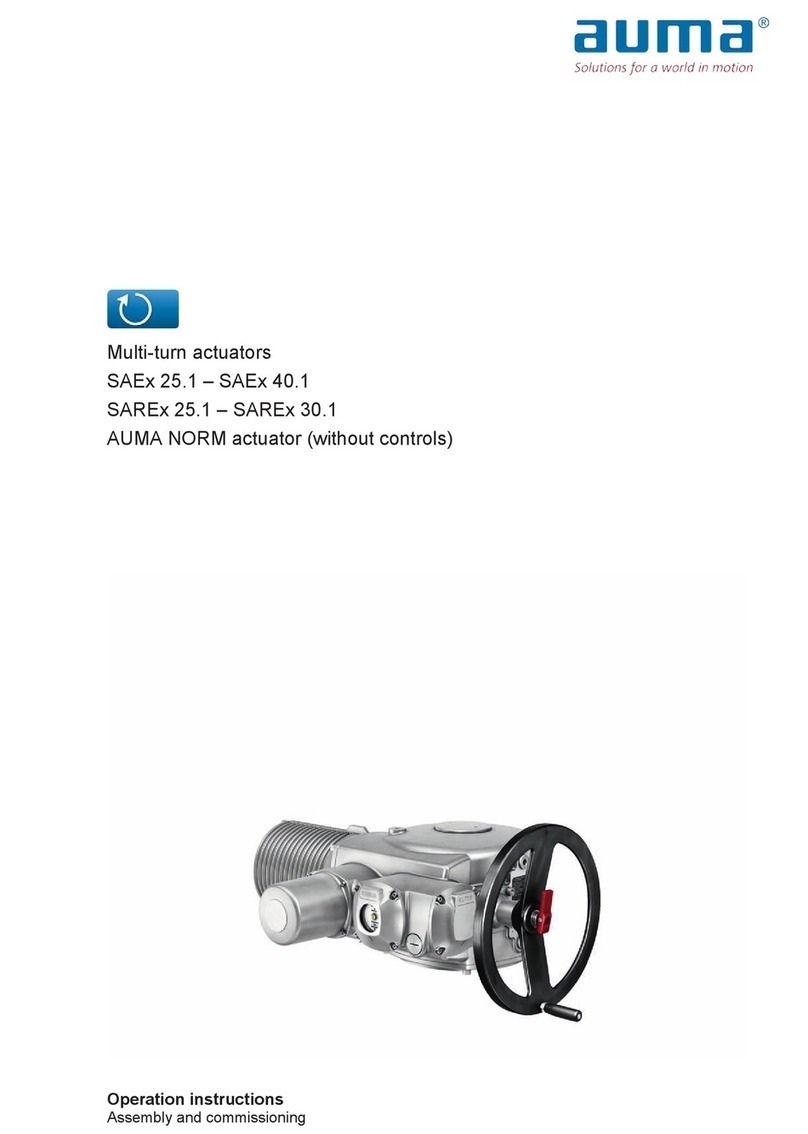
AUMA
AUMA SAEx 25.1 User manual
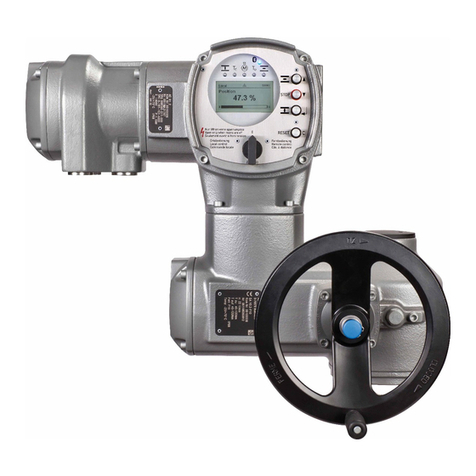
AUMA
AUMA SGExC 05.1 User manual
